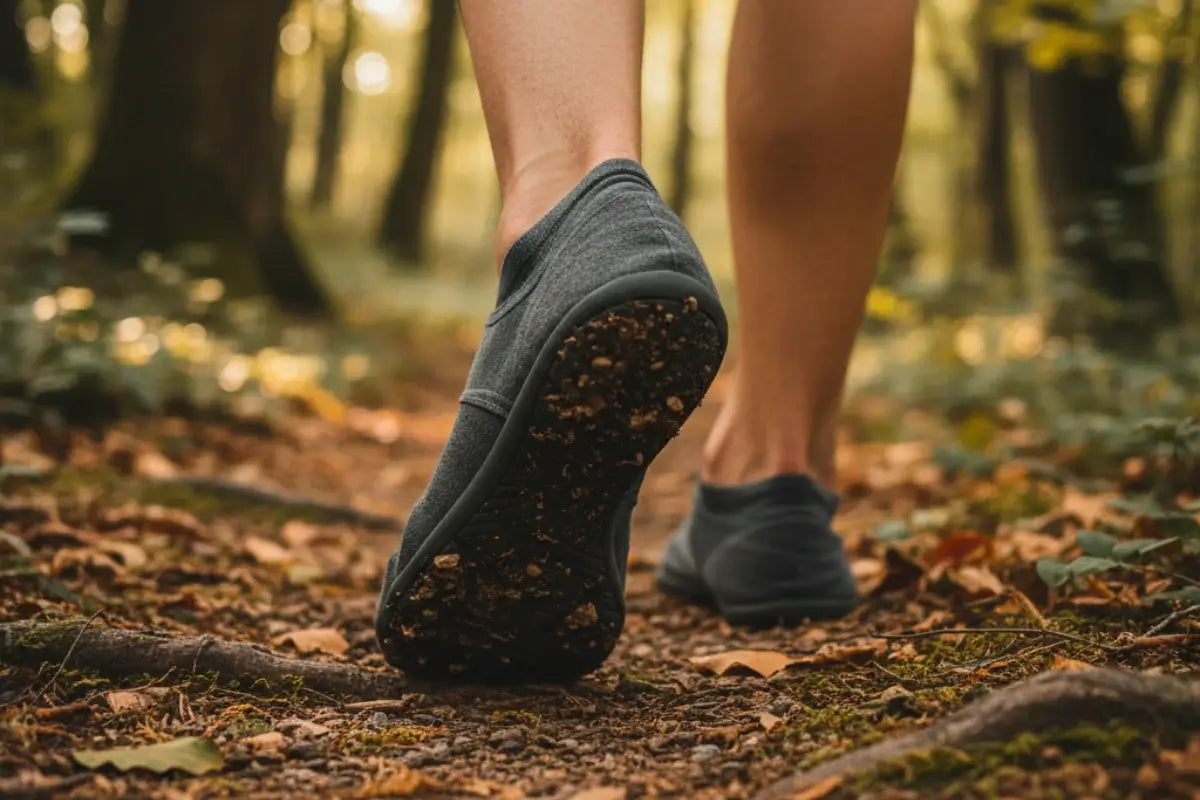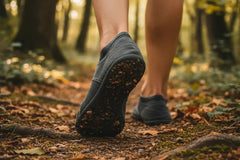How to Transition to Minimalist Shoes Safely?

Switching to minimalist shoes can transform the way your feet feel and move. These lightweight, flexible shoes let your feet work naturally, strengthen muscles, and improve posture.
But jumping in too fast can cause pain or injury. In this guide, you’ll learn step-by-step how to transition safely and enjoy the full benefits.
Table of contents
Key Takeaways
Start Slow: Begin with short walks or indoor use before increasing distance.
Alternate Footwear: Switch between minimalist and traditional shoes during the transition.
Strengthen Your Feet: Do exercises to build stability in your arches, ankles, and calves.
Listen to Your Body: Pause or scale back if you feel pain or discomfort.
Be Patient: Adaptation can take months, so give your muscles and joints time to adjust.
How to Transition to Minimalist Shoes Safely?
Start Slowly: Wear minimalist shoes for short periods indoors at first.
Gradually Increase Use: Slowly increase the time and distance you wear them.
Alternate Shoes: Switch between minimalist and traditional shoes during the transition.
Listen to Your Body: Stop or slow down if you feel pain or discomfort.
Strengthen Your Feet: Do exercises to build foot and ankle muscles.
Be Patient: Give your muscles time to adapt, it can take several months.
What Are Minimalist Shoes?
Minimalist shoes are lightweight footwear designed to mimic barefoot walking while still offering basic protection for the feet.
They feature thin, flexible soles and little to no cushioning, encouraging natural foot movement and strengthening muscles.
Originally popularized for running and athletic use, they are now also worn for everyday activities to promote better posture, balance, and overall foot health.
Why Should I Switch to Minimalist Footwear?
Switching to minimalist footwear is backed by growing scientific evidence, though it comes with some caveats.
Research in Musculoskeletal Care has shown that these shoes can influence lower limb biomechanics and even strengthen intrinsic foot muscles.
Similarly, findings in Sports Health suggest that minimalist shoes encourage a more natural running pattern, shorter ground contact times and fewer rearfoot strikes, closely resembling barefoot running, which may enhance efficiency for some runners.
Long-term benefits are also being explored; for example, BMC Musculoskeletal Disorders reported that elderly women with knee osteoarthritis experienced reduced joint overload and pain relief after months of wearing minimalist shoes.
However, experts warn that the transition must be gradual. Sudden shifts increase risks like stress fractures or Achilles tendon pain, as highlighted in multiple trials.
Reviews in Sports Medicine – Open emphasize careful adaptation, muscle strengthening, and gait retraining as essential steps.
In short, minimalist footwear can improve foot strength, posture, and running efficiency, but its benefits are safest realized when you transition slowly and listen to your body.
How Do Minimalist Shoes Differ from Traditional Shoes?
Minimalist shoes feature thin soles, zero-drop design, and wide toe boxes, encouraging natural foot movement and strengthening muscles.
Traditional shoes have thick, cushioned soles with elevated heels, prioritizing support and protection but potentially weakening foot muscles over time due to restricted movement and less natural alignment.
Can I Transition to Minimalist Shoes If I Have Flat Feet?
Research shows that minimalist shoes can help people with flat feet by strengthening arches, reducing pronation, and improving overall foot function.
They encourage natural movement, activate underused muscles, and may even improve posture and balance.
Some studies also suggest that going minimal can lead to wider, stronger feet and less discomfort over time.
That said, this approach isn’t for everyone, those with severe flat feet, arthritis, or conditions like diabetes often need more supportive footwear.
The biggest risk comes from switching too quickly, which can lead to injuries such as shin splints, Achilles tendonitis, or stress fractures.
Experts highlight the importance of a slow transition with strengthening exercises for the feet, ankles, and hips.
As barefoot running coach Michael Sandler points out, starting with very short distances, just a few hundred yards, and gradually building up allows your body to adapt safely.
Consulting a podiatrist or physical therapist can also help you decide whether minimalist shoes are the right fit for your feet.
Are Minimalist Shoes Suitable for Everyday Use?
Minimalist shoes can be suitable for everyday use once your feet adapt, offering benefits like improved foot strength, natural movement, wide toe boxes, zero-drop soles, and better ground connection.
Gradual transition is essential, while individuals with pre-existing foot conditions or high-impact activities should consult a healthcare provider.

What Are the Risks of Transitioning Too Quickly?
Fertility: Hormone treatments may reduce fertility, sometimes permanently, which is important for those wanting biological children.
Bone and heart health: Puberty blockers and hormones may affect bone density and increase the risk of heart disease, blood clots, or diabetes later.
Irreversible changes: Some changes, like voice deepening or breast growth, are permanent and may cause regret.
Surgical risks: Surgeries can involve bleeding, infection, blood clots, and nerve damage.
Regret and grief: Permanent changes may lead to feelings of regret and grief.
Mental health challenges: Rushing can worsen anxiety, depression, or other existing conditions if underlying issues aren’t addressed.
Social isolation: Detransitioners may face judgment or lose support from their communities.
Lack of support: Some therapists may be hesitant to help people questioning their transition.
High regret rates: Some people medically detransition because the initial transition didn’t suit them.
Overlooked issues: Rapid transitions can miss mental health problems, trauma, or developmental conditions that affect gender dysphoria.
Inadequate assessment: Skipping thorough psychological evaluations increases the risk of regret and detransition.
How Do I Gradually Increase Running Distance in Minimalist Shoes?
To gradually increase running distance in minimalist shoes, start with short walks and brief runs, following the 10% weekly mileage increase rule.
Alternate with cushioned shoes if needed, focus on midfoot or forefoot striking, strengthen feet and lower legs, stretch calves and Achilles, and monitor for pain.
Are Minimalist Shoes Suitable for Trail Running?
Minimalist shoes can suit trail running, offering improved ground feel, agility, and promoting proper midfoot or forefoot strike.
However, they increase injury risk on sharp or technical terrain. Trail-specific models, gradual adaptation, careful foot placement, and hybrid options help mitigate these risks.

What Features Should I Look for in Beginner Minimalist Shoes?
Zero-Drop Platform: The heel and forefoot are level, promoting natural foot movement.
Wide Toe Box: Gives your toes space to spread and move comfortably.
Flexible Sole: Bends and twists easily, allowing your foot to move naturally.
Lightweight Design: Feels easy on your feet, reducing fatigue.
Moderate Cushioning: Slightly thicker sole or soft padding can help beginners adjust from traditional shoes.
FAQ
Can I start running immediately in minimalist shoes?
You cannot start running immediately in minimalist shoes without risking injury; a gradual six- to eight-week transition is essential. Begin with short walks, slowly increase duration and intensity, listen to your body, and allow muscles, tendons, and feet to adapt to prevent stress fractures or tendonitis.
Should I continue using traditional shoes during the transition to minimalist shoes?
Yes, you can continue using traditional shoes during your transition to minimalist shoes, but sparingly. Start with short periods in minimalist shoes, gradually increasing duration. Use traditional shoes for rest, necessary protection, or when pain occurs, while incorporating barefoot time indoors to strengthen foot muscles.




